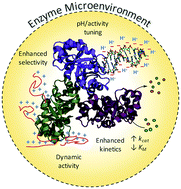当前位置:
X-MOL 学术
›
Chem. Soc. Rev.
›
论文详情
Our official English website, www.x-mol.net, welcomes your feedback! (Note: you will need to create a separate account there.)
Engineering enzyme microenvironments for enhanced biocatalysis
Chemical Society Reviews ( IF 46.2 ) Pub Date : 2018-05-25 00:00:00 , DOI: 10.1039/c8cs00085a Louis Lancaster 1, 2, 3, 4 , Walaa Abdallah 4, 5, 6, 7 , Scott Banta 4, 5, 6, 7 , Ian Wheeldon 1, 2, 3, 4
Chemical Society Reviews ( IF 46.2 ) Pub Date : 2018-05-25 00:00:00 , DOI: 10.1039/c8cs00085a Louis Lancaster 1, 2, 3, 4 , Walaa Abdallah 4, 5, 6, 7 , Scott Banta 4, 5, 6, 7 , Ian Wheeldon 1, 2, 3, 4
Affiliation

|
Protein engineering provides a means to alter protein structure leading to new functions. Much work has focused on the engineering of enzyme active sites to enhance catalytic activity, however there is an increasing trend towards engineering other aspects of biocatalysts as these efforts can also lead to useful improvements. This tutorial discusses recent advances in engineering an enzyme's local chemical and physical environment, with the goal of enhancing enzyme reaction kinetics, substrate selectivity, and activity in harsh conditions (e.g., low or high pH). By introducing stimuli-responsiveness to these enzyme modifications, dynamic control of activity also becomes possible. These new biomolecular and protein engineering techniques are separate and independent from traditional active site engineering and can therefore be applied synergistically to create new biocatalyst technologies with novel functions.
中文翻译:

工程酶微环境可增强生物催化作用
蛋白质工程学提供了一种改变蛋白质结构以产生新功能的方法。许多工作集中在酶活性位点的工程设计上,以增强催化活性,但是,对生物催化剂其他方面进行工程设计的趋势也越来越大,因为这些努力也可以带来有益的改进。本教程讨论了在工程化酶的本地化学和物理环境方面的最新进展,目的是增强酶的反应动力学,底物选择性和在苛刻条件下的活性(例如,低或高pH)。通过引入对这些酶修饰的刺激响应性,动态控制活性也成为可能。这些新的生物分子和蛋白质工程技术与传统的活性位点工程是分开的和独立的,因此可以协同应用以创建具有新颖功能的新生物催化剂技术。
更新日期:2018-05-25
中文翻译:

工程酶微环境可增强生物催化作用
蛋白质工程学提供了一种改变蛋白质结构以产生新功能的方法。许多工作集中在酶活性位点的工程设计上,以增强催化活性,但是,对生物催化剂其他方面进行工程设计的趋势也越来越大,因为这些努力也可以带来有益的改进。本教程讨论了在工程化酶的本地化学和物理环境方面的最新进展,目的是增强酶的反应动力学,底物选择性和在苛刻条件下的活性(例如,低或高pH)。通过引入对这些酶修饰的刺激响应性,动态控制活性也成为可能。这些新的生物分子和蛋白质工程技术与传统的活性位点工程是分开的和独立的,因此可以协同应用以创建具有新颖功能的新生物催化剂技术。



























 京公网安备 11010802027423号
京公网安备 11010802027423号